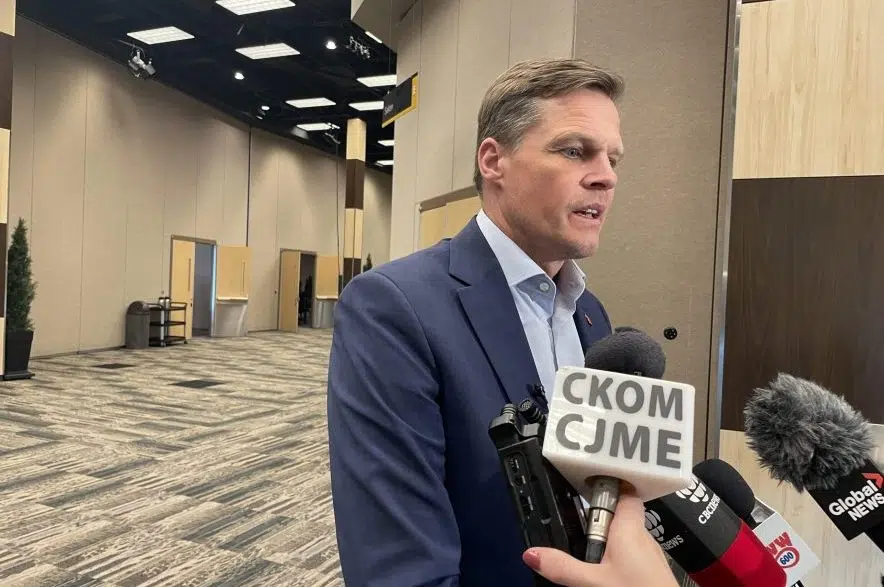Saskatoon’s mayor touted the growth the city has undergone over the past several years during his “State of the City” address Tuesday.
Charlie Clark said he’s excited to see even greater progress take place in the decades to come.
Taking the podium at TCU Place before members of the local chamber of commerce, Clark took a trip down memory lane to 2006 when he first decided to throw his hat into municipal politics.
Commenting on a statistic shared by University of Saskatchewan president Peter Stoicheff, Clark shared that two decades ago, about 75 per cent of graduates from the university were leaving the province. Now, he said that statistic has been reversed.
“This is really remarkable,” Clark said, adding that it reminds him why he got into politics as a young family man in 2006. His son was just 15 months at the time, and Clark said he and his wife were concerned to see so many young people leaving Saskatoon.
Now, Clark said his oldest son tells him most of his friends want to stay in Saskatoon.
Clark asked the what it takes for a city to transform itself. Having grown to 288,000 people, Clark spoke about the physical expansion Saskatoon has seen over the past 15 years. Numerous neighbourhoods have been added, like Stonebridge, Brighton and Rosewood, as well as the additions of bridges and more facilities and gathering places like Persephone Theatre, the Remai Modern gallery, Merlis Belsher Place and River Landing.
The mayor highlighted the partnerships it takes for those accomplishments to happen.
Saskatoon is currently on track to reach 500,000 residents in the next 20 years, Clark said, and greater resource development has helped the city become a place that can deliver what the world needs.
He said more than 15,000 jobs were created in the Saskatoon area in 2022 alone.
Clark said significant work on the development of the proposed downtown arena and entertainment district is ongoing. It’s the largest project ever in the city, and the mayor said it will come with a significant cost.
But, Clark told reporters after his speech, it also comes with a great cost to not proceed with that plan.
“We have to recognize that whatever we do will have consequences,” Clark said.
While some residents are calling for a referendum on the issue, Clark said there is no choice between doing something and not, because to not act would put the city at risk.
Instead, Clark said city staff and technological advisors are crunching numbers to deliver a financial plan, avoiding an increase to property taxes as much as possible. The mayor said that work will likely be completed later this year.
Clark said Saskatoon currently has an entertainment venue in SaskTel Centre that is much older than other venues around the country. For the upcoming Shania Twain concert, he said portable toilets will have to be brought in to accommodate the large crowd. Should Saskatoon win its bid to host the 2025 World Junior Championship, Clark said mobile showers and trailers for change rooms would be required.
“What we have now is fine. It can work for today,” Clark said. “What’s fine today will not be fine in 10 years.”
Clark said he doesn’t want Saskatoon to be a city that is flown over by bigger acts because of its outdated facilities.
He said the city knows it cannot rely on property taxes alone to accommodate that growth, however, and referenced tax increment financing, private donations and leveraging whatever the city is able to in order to avoid raising taxes to build the arena and downtown entertainment district.
While change can be difficult, Clark said it is the city’s job to build and develop the community.
Clark said the city is also preparing to craft its next multi-year budget, which he called “one of the most challenging budgets we’ll face.”
Commenting on inflation and high costs associated with road repairs, snow removal and homelessness, Clark noted the city’s work is cut out for it in the upcoming budget.
Clark said there is a balance to providing the services that are essential to the quality of life people want in Saskatoon while mitigating taxes. The mayor said inflation and ongoing shortfalls from the COVID-19 pandemic and adding critical items like snow removal have left funds stretched.
“If we want to make sure that we’re really keeping the quality of life here good and ensuring this is a place people want to stay … I don’t know what cuts could be made that wouldn’t have those kinds of implications,” he said.
Clark acknowledged the ongoing need to address homelessness and addictions, issues which continue to worsen in the city. He commended Saskatoon Tribal Council Chief Mark Arcand and other Indigenous-led organizations for their work and partnership in addressing some of those concerns and bettering the community.
The mayor said recent developments in rare earth minerals, vaccine development and crop production, as well as new partnerships with Indigenous communities, have helped create a “new era” for the city.
“It’s extremely exciting and it’s remarkable to be able to be here at this time,” Clark said.











